SCHOOLS: Covid-19 Data and K-12 Education (1/14/2021)
American Academy of Pediatrics. (2021). Children and COVID-19: State-Level Data Report. 2021. Available in: https://downloads.aap.org/AAP/PDF/AAP%20and%20CHA%20-%20Children%20and%20COVID-19%20State%20Data%20Report%201.14.21.pdf
In the midst of the Covid-19 pandemic, States are struggling to reopen and keep open, most, if not all, of their 138,000 K-12 schools. This will have an impact on 55 million students, 6 million teachers and education staff, and all of the families of those involved. It is being done despite significant uncertainty as to the impact Covid-19 will have on the health of students and education staff. And ultimately, there is the question of how effective education will be in the context of different schedules, models, distractions, potential school closures, and remote learning.
Given this level of uncertainty, it is critical to track data that will help schools identify problems quickly, assess their nature, and respond in timely and effective ways to safeguard the health of students and education staff while providing a quality education. This Wing Institute dashboard will on track issues regarding the reopening of schools under the Covid-19 pandemic. It will provide relevant, up-to-date research and data on in the following areas:
- Student health (recent research, data on exposure, infections, intensive care use, and deaths)
- Staff health (recent research, data on exposure, infections, intensive ward, deaths
- School health (recent research, models, school openings, school closings
- Student performance (student absenteeism, academic performance, social behavioral issues)
Table of Contents
- Student Health: Total Number of Child Covid-19 Cases
- Student Health: Growth Rate in Covid-19 Total Cases Over Recent Weeks
- Student Health: Number and Growth Rate of Covid-19 Cases per 100,000 Children
- Student Health: Total Number of Children Hospitalized for Covid-19
- Student Health: Percent of Children Requiring Hospitalization
- Student Health: Total Number of Child Covid-19 Deaths
- Student Health: Percent of Child Covid-19 Cases Resulting in Death
Figure 1. Student Health: Total Number of Child Covid-19 Cases

As of January 14, 2021, there are over 2.5 million children who have been identified as having, or having had, the Covid-19 virus.
Figure 2. Student Health: Growth Rate in Covid-19 Total Cases Over Recent Weeks
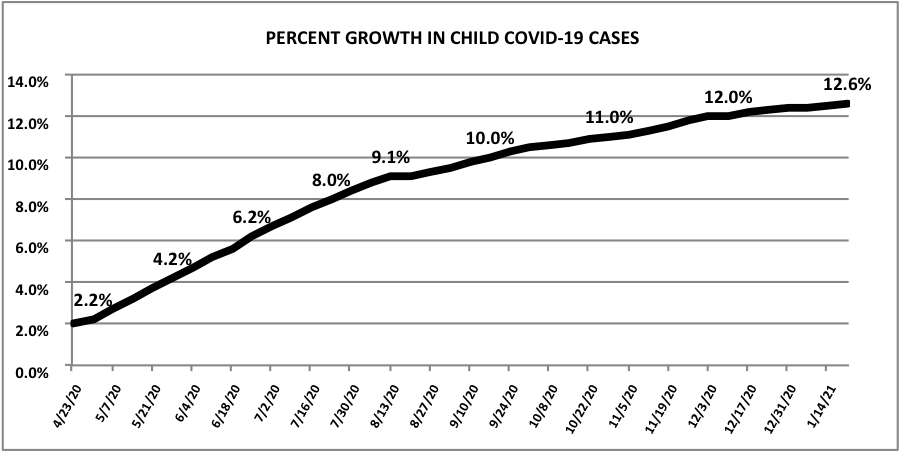
The percent growth in the number of children with Covid-19 had accelerated every week since April 16, 2020, rising from a 2.2% weekly increase to a 11.9% weekly growth.
Figure 3. Student Health: Number of Covid-19 Cases per 100,000 Children 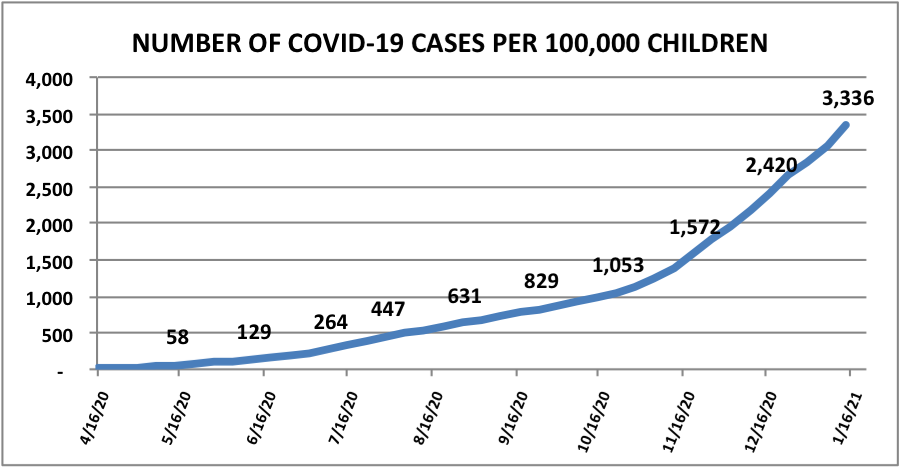
The number of Covid-19 cases per children is an even more important number because it is a metric of infection that is irrespective of the number of children tested. This data shows a growth rate of 20% over the last two weeks alone, and a doubling over the past ten weeks
Figure 4. Student Health: Total Number of Children Hospitalized for Covid-19 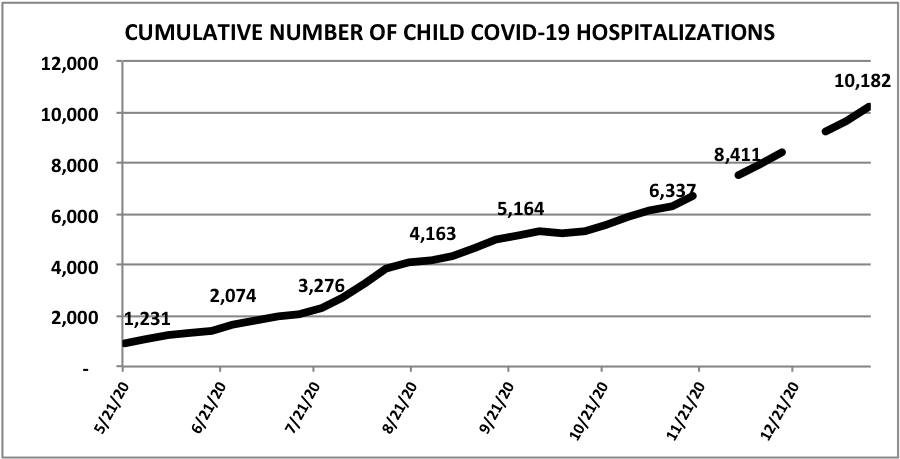
The total number of children who have been hospitalized due to Covid-19 continues to increase.
Figure 5. Student Health: Percent of Children Requiring Hospitalization
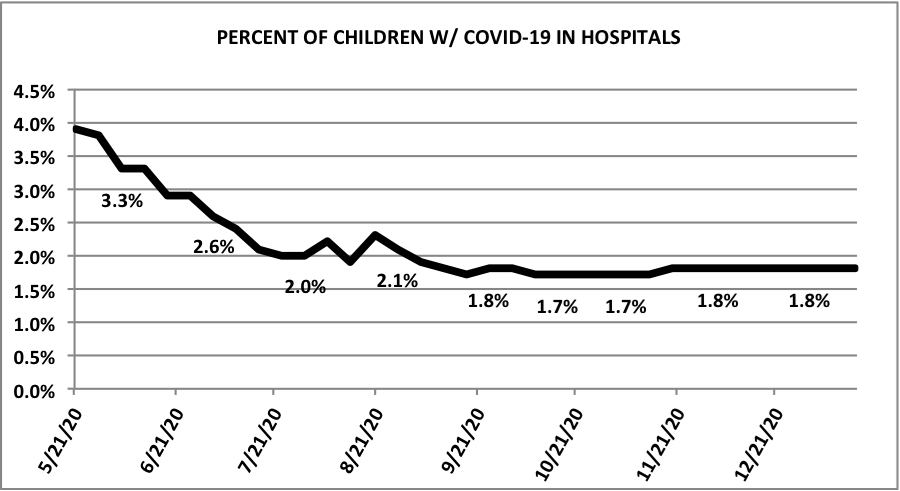
But the percent of children who require hospitalization due to Covid-19 remains very low and steady.
Figure 6. Student Health: Total Number of Child Covid-19 Deaths
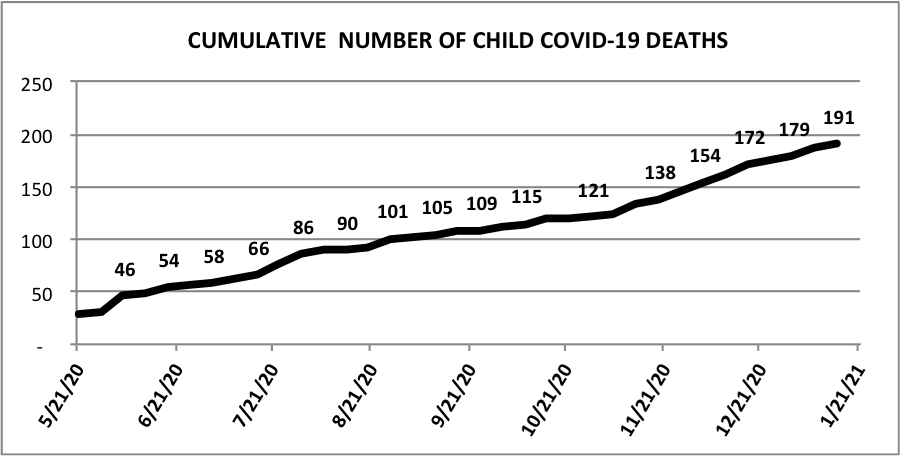
The number of children who have died from the Covid-19 virus has been very small.
Figure 7. Student Health: Percent of Child Covid-19 Cases Resulting in Death 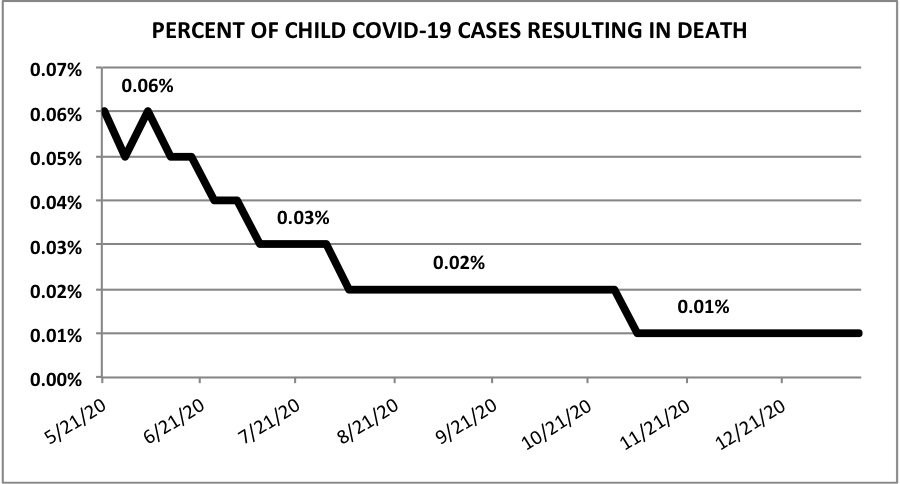
The percent of children who have died is extremely small, and has actually dropped steadily over the past four months.
For Access to past data
Spring 2020
January 2021
Publications
TITLE
SYNOPSIS
CITATION
LINK
Creating a Dashboard to Monitor the Reopening of Schools: The Baseline
In the midst of the Covid-19 pandemic, States will soon reopen most, if not all, of their 138,000 K-12 schools and 55 million students will return to the classroom. As most of the research is still in its early stage, and there is no data yet on the reopening schools, this analysis starts with a baseline of the information we have to date for I. student health and II. staff health.
Keyworth, R., & States, J. (2020). Creating a Dashboard to Monitor the Reopening of Schools: The Baseline. Oakland, CA: The Wing Institute. https://www.winginstitute.org/covid-19-impact.
TITLE
SYNOPSIS
CITATION
LINK
Fears of a mass exodus of retiring teachers during COVID-19 may have been overblown
One-third of teachers told Education Week in July they were somewhat or very likely to leave their job this year, compared with just 8% who leave the profession in a typical year. But while that survey might reflect teachers' feelings over the summer, a review of the retirement and staffing figures collected in some of the first states to resume classes this year suggests that fears of a mass exodus of retiring teachers may have been overblown.
Aspegren, E. (2020, October 8). Fears of a mass exodus of retiring teachers during COVID-19 may have been overblown. USA Today.
Ventilation rates in recently constructed U.S. school classrooms
Low ventilation rates (VRs) in schools have been associated with absenteeism, poorer academic performance, and teacher dissatisfaction. The steady-state, build-up, and decay methods had significant limitations and biases, showing the need to confirm that these methods are appropriate. Findings highlight the need to increase VRs and to ensure that energy saving and comfort measures do not compromise ventilation and IAQ.
Batterman, S. T. U. A. R. T., Su, F. C., Wald, A., Watkins, F., Godwin, C., & Thun, G. (2017). Ventilation rates in recently constructed US school classrooms. Indoor Air, 27(5), 880-890.
Creating coherence in the teacher shortage debate: What policy leaders should know and do
The Education Policy Center at American Institutes for Research (AIR) provides rigorous
research-and evidence-based perspectives on education issues spanning prekindergarten
to careers, including reports, briefs, legislative guides, and our InformED blog—all written by
AIR experts.
Behrstock-Sherratt, E. (2016). Creating Coherence in the Teacher Shortage Debate: What Policy Leaders Should Know and Do. Education Policy Center at American Institutes for Research.
Analysis: Spring exams are the best shot state leaders have at knowing what’s happening with their students.
As 2021 begins, we can’t make assumptions about what students have learned this school year. Education leaders and teachers, of course, have interacted with students and watched them through computer screens for many months — but we won’t truly know what happened and where learning gaps exist without statewide exams.
Bell-Ellwanger, J. (2021, January 5). Analysis: Spring exams are the best shot state leaders have at knowing what’s happening with their students. The 74
Remote Learning Overview
The Covid-19 pandemic has resulted in school closings for the remainder of the year in 48 of 50 states and a sharp turn toward remote instruction in order to finish the year as best as possible. Understanding best practice in remote instruction and learning will be key as schools look to the future.
Improving Attendance in a Remote Learning Environment
In the current context, barriers to student attendance and engagement have only increased. Schools and districts are encouraged to emphasize a supportive multi-tiered model for supporting student and staff engagement and attendance rather than punitive attendance or truancy policies.
Freeman, J., Flannery, B., Sugai, G., Goodman, S., Simonsen, B., & Barrett, S. (2020). Improving Attendance in a Remote Learning Environment. Technical Assistance Center on Positive Behavioral Interventions and Supports.
Education secretary’s first task: Curb standardized tests.
Although recent data indicate that the learning losses this fall, compared with the same period last year, have not been as dire as predicted, those results likely mask high numbers of missing kids — children who lack technology for online learning or whose parents are unable to supervise their remote schooling.
Gabor, A. (2020, December 27). Education secretary’s first task: Curb standardized tests. Pittsburgh Post-Gazette
It’s official: All states have been excused from statewide testing this year
In one three-week period, a pandemic has completely changed the national landscape on assessment.
Gewertz, C. (2020). It’s official: All states have been excused from statewide testing this year. Education Week.
How technology, coronavirus will change teaching by 2025
In early March, Education Week caught up with them by phone when they were in Paris to speak at an ed-tech conference. We asked them how their 2015 predictions had fared. Then, we talked again in late April, when the coronavirus had suddenly transformed K-12 education into a massive remote learning system.
Gewertz, C. (2020, June 2). How technology, coronavirus will change teaching by 2025. Education Week. https://www.edweek.org/ew/articles/2020/06/03/how-technology-coronavirus-will-change-teaching-by.html
Sustaining Teacher Training in a Shifting Environment
This brief is one in a series aimed at providing K-12 education decision makers and advocates with an evidence base to ground discussions about how to best serve students during and following the novel coronavirus pandemic. Student teaching placements influence teacher effectiveness. If student teaching experiences are constrained by the pandemic, teacher candidates may lose valuable experiences and schools may lose the opportunity to shape and evaluate prospective hires.
Goldhaber, D., & Ronfeldt, M. (2020). Sustaining Teacher Training in a Shifting Environment. Brief No. 7. EdResearch for Recovery Project.
Schools should scrap the big standardized test this year.
When schools pushed the pandemic pause button last spring, one of the casualties was the annual ritual of taking the Big Standardized Test. There were many reasons to skip the test, but in the end, students simply weren’t in school during the usual testing time
Greene, P. (2020, August 14). Schools should scrap the big standardized test this year. Forbes
Amid Pandemic, Support Soars for Online Learning, Parent Poll Shows:
The survey was conducted in May 2020. While this was early in the Covid-19 pandemic, unemployment was already 14.7%, the economy in recession, and the schools were shutdown. This survey provides one of the first opportunities to evaluate the public’s views on education in this context
Henderson, M. B., Houston, D. M., Peterson, P. E., West, M. R. & Shakeel, M. D. (2020). Amid Pandemic, Support Soars for Online Learning, Parent Poll Shows Results from the 2020 Education Next Survey of Public Opinion. Education Next, 20(13), 8-19. https://www.educationnext.org/amid-pandemic-support-soars-online-learning-parent-poll-shows-2020-education-next-survey-public-opinion/
Amid Pandemic, Support Soars for Online Learning, Parent Poll Shows:
The survey was conducted in May 2020. While this was early in the Covid-19 pandemic, unemployment was already 14.7%, the economy in recession, and the schools were shutdown. This survey provides one of the first opportunities to evaluate the public’s views on education in this context.
Henderson, M. B., Houston, D. M., Peterson, P. E., West, M. R. & Shakeel, M. D. (2020). Amid Pandemic, Support Soars for Online Learning, Parent Poll Shows Results from the 2020 Education Next Survey of Public Opinion. Education Next, 20(13), 8-19.
The disparities in remote learning under coronavirus (in charts)
The messy transition to remote learning in America’s K-12 education system as a result of the COVID-19 pandemic has been marked by glaring disparities among schools, according to nationally representative surveys of U.S. teachers and school district leaders administered by the EdWeek Research Center.
Herold, B. (2020, April 10). The disparities in remote learning under coronavirus (in charts). Education Week.https://www.edweek.org/ew/articles/2020/04/10/the-disparities-in-remote-learning-under-coronavirus.html
Combatting COVID-19’s effect on children
The COVID-19 pandemic is harming health, social and material well-being of children worldwide, with the poorest children, including homeless children and children in detention, hit hardest. School closures, social distancing and confinement increase the risk of poor nutrition among children, their exposure to domestic violence, increase their anxiety and stress, and reduce access to vital family and care services.
Home, O. E. C. D. Combatting COVID-19’s effect on children.
The rise of K–12 blended learning.
Online learning is sweeping across America. In the year 2000, roughly 45,000 K–12 students took an online course. In 2009, more than 3 million K–12 students did. What was originally a distance-learning phenomenon no longer is. Most of the growth is occurring in blended-learning environments, in which students learn online in an adult-supervised environment at least part of the time. As this happens, online learning has the potential to transform America’s education system by serving as the backbone of a system that offers more personalized learning approaches for all students.
Horn, M., & Staker, H. (2011). The rise of K–12 blended learning. Mountain View, CA: Innosight Institute.
Dropout Prevention in the Time of COVID-19
Students on the path toward dropping out of high school often exhibit signals that they are at risk well before they stop engaging in school. As school closures due to COVID-19 separate students from structured routines and educational supports, the number of disengaged students may continue to grow.
Kassner, L., Jonas, D., and Klein, S. (2020). Dropout Prevention in the Time of COVID-19. U.S. Department of Education, Institute of Education Sciences, National Center for Education Evaluation and Regional Assistance, What Works Clearinghouse.
The accidental education benefits of Covid-19
The accidental education benefits of Covid-19.
Kohn, A. (2020, August 18). The accidental education benefits of Covid-19. Education Week.
Promising strategies to prepare new teachers in a COVID-19 world
The coronavirus disease 2019 (COVID-19) crisis will undoubtedly have dire consequences
for all sectors of public education. The rapid transition to remote modes of instruction in the
spring of 2020 and the subsequent anxiety about the start of the 2020–21 academic year
have highlighted the critical need for well-prepared educators.
Lachlan, L., Kimmel, L., Mizrav, E., & Holdheide, L. (2020). Advancing Quality Teaching for All Schools: Examining the Impact of COVID-19 on the Teaching Workforce. Center on Great Teachers and Leaders.
Learning as We Go: Principles for Effective Assessment during the COVID-19 Pandemic
We did not ask the panel to weigh in on debates over the role of state exams and accountability systems during a pandemic. However, the panel did discuss how districts and states can balance the goal of informing teachers and parents about individual students with the continued need to track system and school progress. The challenges in the upcoming school year will shine a harsh light on the variation in skills, knowledge, and needs that were always present.
Lake, R., & Olson, L. (2020). Learning as We Go: Principles for Effective Assessment during the COVID-19 Pandemic. Center on Reinventing Public Education.
NEPC Review: “Student Assessment During COVID-19.”
School closings and the ever-increasing number of deaths provide the backdrop for a proposal by the Center for American Progress (CAP) to deny waivers of the federally mandated administration of standardized tests in spring 2021. Further, the federal government proposes to add to those assessments in ways that CAP argues would make the test results more useful.
Mathis, W. J., Berliner, D. C., & Glass, G. V. NEPC Review: Student Assessment During COVID-19 (Center for American Progress, September 2020).
Virtual schools in the U.S. 2019
This report provides disinterested scholarly analyses of the characteristics and performance of fulltime, publicly funded K-12 virtual schools; reviews the relevant available research related to virtual school practices; provides an overview of recent state legislative efforts to craft virtual schools policy; and offers policy recommendations based on the available evidence.
Molnar, A., Miron, G., Elgeberi, N., Barbour, M. K., Huerta, L., Shafer, S. R., & Rice, J. K. (2019). Virtual schools in the U.S. 2019. Boulder, CO: National Education Policy Center. https://nepc.colorado.edu/sites/default/files/publications/Virtual%20Schools%202019.pdf
Principals’ Perceptions of Influence Over Decisions at Their Schools in 2017-2018
This Data Point examines the relationship between public and private school principals’ perceived influence over various decisions made at their schools before the coronavirus pandemic. This information was reported by U.S private and public school principals on the principal survey of the 2017–18 National Teacher and Principal Survey.
National Center for Education Statistics at IES. (2021). Principals’ Perceptions of Influence Over Decisions at Their Schools in 2017-2018.
Learning remotely when schools close: How well are students and schools prepared? Insights from PISA.
That being said, the Covid-19 crisis strikes at a point when most of the education systems covered by the OECD’s latest round of the Programme for International Student Assessment (PISA) are not ready for the world of digital learning opportunities. Below are some sobering numbers.
OECD (2020). Learning remotely when schools close: How well are students and schools prepared? Insights from PISA.
Teacher Prep Review: Clinical Practice and Classroom Management
The COVID pandemic has meant that large numbers of students are learning by Zoom instead of in classrooms, and schools are struggling to reach students who don't have sufficient access to the internet or computers. In all this disruption, there is still one constant: the importance of effective, skilled teachers.
Pomerance, L., & Walsh, K. (2020). 2020 Teacher Prep Review: Clinical Practice & Classroom Management. National Council on Teacher Quality.
2020 teacher prep review: Clinical practice and classroom management.
For many students, school this year looks very different from the way it did in the past. The COVID pandemic has meant that large numbers of students are learning by Zoom instead of in classrooms, and schools are struggling to reach students who don’t have sufficient access to the internet or computers. In all this disruption, there is still one constant: the importance of effective, skilled teachers.
Pomerance, L., & Walsh, K. (2020). 2020 Teacher Prep Review: Clinical Practice & Classroom Management. National Council on Teacher Quality.
Driven by Data: Using Licensure Tests to Build a Strong, Diverse Teacher Workforce
The quality of the teacher workforce is especially important in the early grades, when teachers bear an extraordinary responsibility, building a solid foundation for students in both the knowledge and skills they will need to succeed in later grades, as well as in their future lives. The past year and a half has laid bare the tremendous challenges teachers face and the essential role they play in supporting students. As the pandemic abates and we reckon with the damage it wrought, we must acknowledge that recovery places unprecedented demands on our education system and its teachers.
Putman, H. & Walsh, K. (2021). Driven by Data: Using Licensure Tests to Build a Strong, Diverse Teacher Workforce. Washington, D.C.: National Council on Teacher Quality.
State of the states: Teacher preparation policy
Children across the country face unprecedented levels of missed instruction as a result of the pandemic. As millions of students and teachers continue remote learning, experiment with hybrid models, and ultimately return to their classrooms, our nation has a greater need than ever for teachers who have the skills to address the challenges ahead.
Putman, H., & Walsh, K. (2021). State of the States 2021: Teacher Preparation Policy. National Council on Teacher Quality.
Getting testy about testing: K–12 parents support canceling standardized testing this spring. That might not be a good idea.
n the before-times, one of the hallmarks of spring for parents, students and teachers was the ramp-up toward federally mandated standardized tests. COVID-19 had something to say about that last school year, and in mid-March, the U.S. Department of Education granted states a blanket exemption from standardized testing.
Silver, D. & Polikoff, M. (2020, November 16). Getting testy about testing: K–12 parents support canceling standardized testing this spring. That might not be a good idea. The 74.
10 strategies for online learning during a coronavirus outbreak.
Members of ISTE’s professional learning networks have been hard at work identifying key practices for successful online learning. Here are some of the best ideas from educators from around the world, many of whom have already been teaching during coronavirus closures.
Snelling, J., & Fingal, D. (2020, March 16). 10 strategies for online learning during a coronavirus outbreak. Washington, DC: International Society for Technology in Education. https://www.iste.org/explore/learning-during-covid-19/10-strategies-online-learning-during-coronavirus-outbreak
Supporting Positive At-Home Behaviors Among Elementary Students
The COVID-19 pandemic has suddenly shifted classroom learning to the home and has required parents and other caregivers to take on the role of teacher and behavior manager. In many homes, this rapid shift in roles and a new learning environment for students has led to frustration and possible learning loss.
Taylor, M. (2020). Supporting Positive At-Home Behaviors Among Elementary Students. U.S. Department of Education, Institute of Education Sciences, National Center for Education Evaluation and Regional Assistance, What Works Clearinghouse.
Back-to-school metrics: How to assess conditions for teaching and learning and to measure student progress during the COVID-19 pandemic.
The continuing COVID-19 pandemic has forced school districts across the nation to quickly adapt their approach to teaching and learning, with widespread variation in the response. With a new school year now underway, several states require that schools provide some degree of in-person instruction, while other states have left such decisions up to local education and public health officials.
Therriault, S. B. (2020). Back-to-school metrics: How to assess conditions for teaching and learning and to measure student progress during the COVID-19 pandemic. Regional Education Laboratory Program (REL).
Teachers say they are more likely to leave the classroom because of coronavirus
Two-thirds of educators say they’re concerned about the health implications of resuming in-person instruction in the fall, and some say the coronavirus outbreak—and its dramatic effects on schooling—has increased the likelihood that they will leave the classroom altogether.
Will, M. (2020). Teachers say they’re more likely to leave the classroom because of coronavirus. Education Week.







